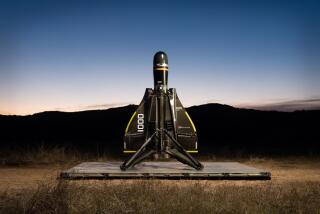Maker of ocean-going robots looking to expand government business
- Share via
LAS VEGAS -- A Sunnyvale company that makes long-endurance glider robots used by marine scientists and oil companies to study the ocean is looking to land more government work.
Liquid Robotics makes unmanned vehicles, called Wave Gliders, that float on the ocean’s surface and generate power through the ebb and flow of the ocean. (See it operate in the video below.)
Because it converts wave motion into thrust, the wake-board-like device can travel to a distant area, collect data and return for maintenance for a year at a time.
The gliders, which are outfitted with advanced sensors and can communicate with one another, have been used by scientists to measure storms, oil companies to examine sea beds, and the Navy for reconnaissance missions.
Now, Liquid Robotics wants more lucrative government work at home and abroad. The company believes that its technology is ideal for spy missions and intelligence gathering. This week, it set up a business unit to deal exclusively with governments.
The company made the announcement at this week’s Assn. for Unmanned Vehicle Systems International trade show, where more than 500 robot makers have gathered to show off their wares.
“Across the government we are experiencing heightened demand for and interest in the Wave Glider’s long endurance and persistent surveillance, communications, and advanced
capabilities,” Chief Executive Bill Vass said in a statement.
It’s not your typical defense contractor. With executives that once worked for companies such as Google Inc. and Sun Microsystems Inc., Liquid Robotics is run more like a Silicon Valley firm.
ALSO:
Boeing technology enables drones to swarm like insects
Skunk Works’ engineers develop drone that feeds on laser power
Raytheon develops 13-pound “smart bomb” for drone aircraft [Video]
Follow W.J. Hennigan on Twitter or Google+
More to Read
Inside the business of entertainment
The Wide Shot brings you news, analysis and insights on everything from streaming wars to production — and what it all means for the future.
You may occasionally receive promotional content from the Los Angeles Times.










